Wiza Alternatives
A direct comparison of 10 Wiza alternatives. We review each tool's features, pricing, and performance to help you find a replacement.
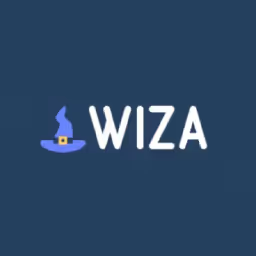
Wiza is a helpful tool for many sales and recruiting teams. It performs well when you need to find verified email addresses and phone numbers directly from LinkedIn. Its ability to quickly build outreach lists from Sales Navigator searches is a common reason people use it.
However, some users report that the pricing and credit limits can be a drawback. For these reasons, you might be looking for an alternative. We've analyzed the top options based on G2 reviews, comparing their pros and cons to help you decide. Let's get started.
Consider 11x Digital Workers
If your sales team is exploring automation, consider using digital workers. They handle repetitive tasks, freeing up your representatives to focus on building relationships and closing deals.
11x provides these digital workers for sales functions. They can manage lead research, data enrichment, and personalized outreach campaigns based on your specific instructions.
At 11x, our GTM platform uses AI agents to manage the sales process. The agent Alice finds prospects, runs outreach on email and LinkedIn, and keeps the CRM updated.
Julian, a second agent, qualifies inbound leads and books meetings. The platform unifies data enrichment, outreach, and email warmup, so you do not need separate tools.
Wiza Alternatives
Below, we review the top Wiza alternatives in detail. Each review covers core features, pricing, and the main pros and cons compared to Wiza to help you make an informed decision.
1) Apollo.io
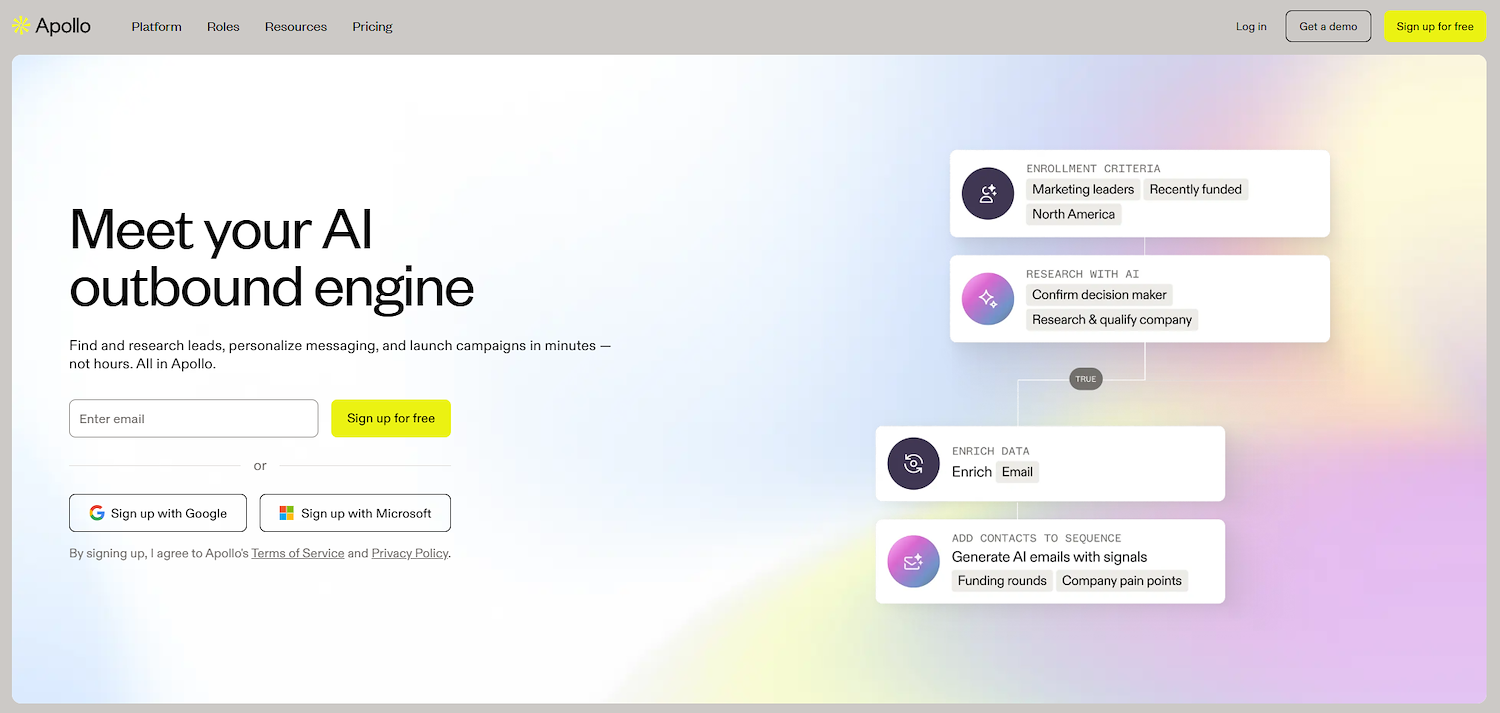
Apollo.io is a sales platform with a database of B2B contacts. It provides verified emails and direct-dial phone numbers. Sales teams use it to build prospect lists and enrich data in their CRM systems.
The platform also has sales engagement tools. Teams can execute outreach sequences and track the results through a unified interface.
Apollo.io's Main Features
- Enriches data directly within your CRM systems.
- Includes sales engagement tools to execute outreach sequences.
- Tracks outreach results through a unified interface.
Apollo.io vs. Wiza: A Comparison
Average Review score: 4.7/5 stars based on 8,904 G2 reviews.
- Apollo.io functions as an end-to-end sales platform with built-in engagement and analytics, a broader scope compared to Wiza's focus on extracting contact data from LinkedIn.
- The tool includes its own database of over 210 million contacts, offering a different approach to lead generation than Wiza's real-time LinkedIn data extraction.
- Users can execute and track outreach sequences directly within the platform, whereas Wiza primarily builds prospect lists for use in other engagement tools.
- It enriches contact data directly in your CRM as part of its integrated suite, while Wiza's enrichment is more of a standalone function.
Potential Downsides of Apollo.io
- Wiza verifies contact data in real time directly from LinkedIn. In contrast, some users report that Apollo.io's static database can sometimes contain information that is out of date.
- The platform offers an extensive suite of sales tools. This may create a learning curve for teams that only require a simple contact extraction function like the one Wiza provides.
- Its all-in-one design might be less suitable for teams that already have an established sales tech stack. Wiza integrates by simply providing contact lists for use in other existing tools.
Pricing and Cost-Effectiveness
Both platforms offer free plans and identically priced starter tiers at $49 per user per month. Apollo.io becomes more cost-effective on higher tiers; its Professional plan is $79 per user, while its Organization plan for three users is $119, which is lower than Wiza's comparable plans.
2) ZoomInfo SalesOS
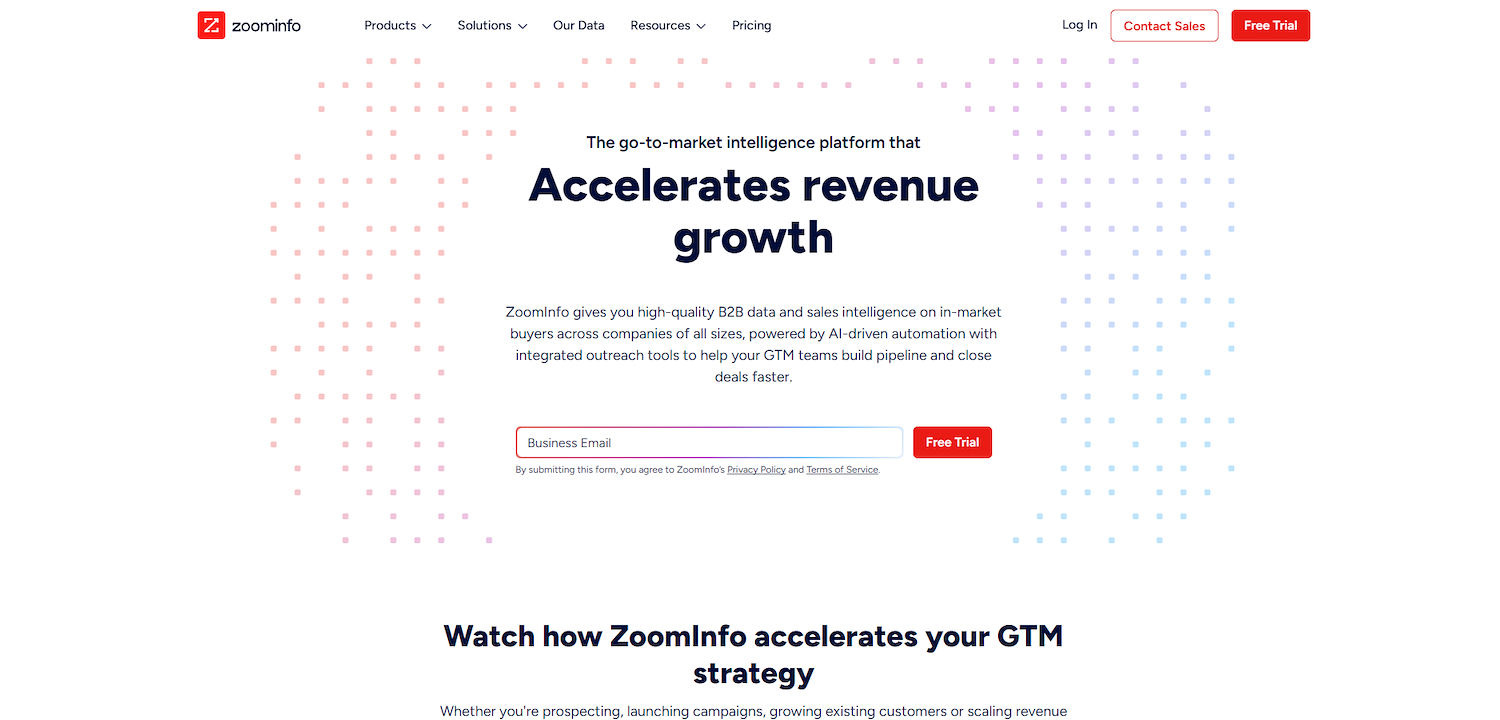
ZoomInfo SalesOS is a go-to-market intelligence platform. It helps B2B organizations identify and connect with buyers. The system unifies contact and company data with buyer-intent signals and engagement tools in a single platform for revenue teams.
Sales teams use it to build lead lists with verified contact information. The platform serves sales, marketing, and recruiting functions for companies of various sizes.
ZoomInfo SalesOS's Main Features
- Identifies ready-to-buy prospects using real-time intent signals.
- Analyzes call and meeting interactions with its conversation intelligence tool.
- Includes a generative AI companion that surfaces insights and drafts outreach.
- Turns anonymous website page views into sales pipeline through visitor tracking.
ZoomInfo SalesOS vs. Wiza: A Comparison
Average Review score: 4.5/5 stars based on 8,738 G2 reviews.
- ZoomInfo SalesOS provides its own large database of B2B contacts, which differs from Wiza’s method of real-time data extraction from LinkedIn.
- It includes buyer intent data to help identify prospects actively researching solutions, a feature that Wiza does not offer.
- The platform has a generative AI companion that gives recommendations on who to contact and what to say, providing more sales guidance than Wiza's list-building function.
- Unlike Wiza, which exports lists for other tools, ZoomInfo SalesOS functions as a more complete platform with its own sales engagement and data orchestration features.
Potential Downsides of ZoomInfo SalesOS
- Some users find that its static database can contain outdated information. Wiza, by contrast, verifies contact data in real time directly from LinkedIn, which can provide more current details.
- Its comprehensive suite of tools can introduce a learning curve for new users. Teams that only need a simple contact extraction function, like Wiza provides, might find the platform's scope too broad.
- The platform typically requires an annual contract and custom pricing. This structure is less flexible compared to Wiza's per-user monthly plans, which may be preferable for teams avoiding long-term commitments.
Pricing and Cost-Effectiveness
Wiza offers transparent monthly plans starting at $49 per user. In contrast, ZoomInfo SalesOS does not publish its prices and operates on a custom quote basis. For accurate pricing information, we recommend visiting the ZoomInfo SalesOS's official website.
3) Lusha
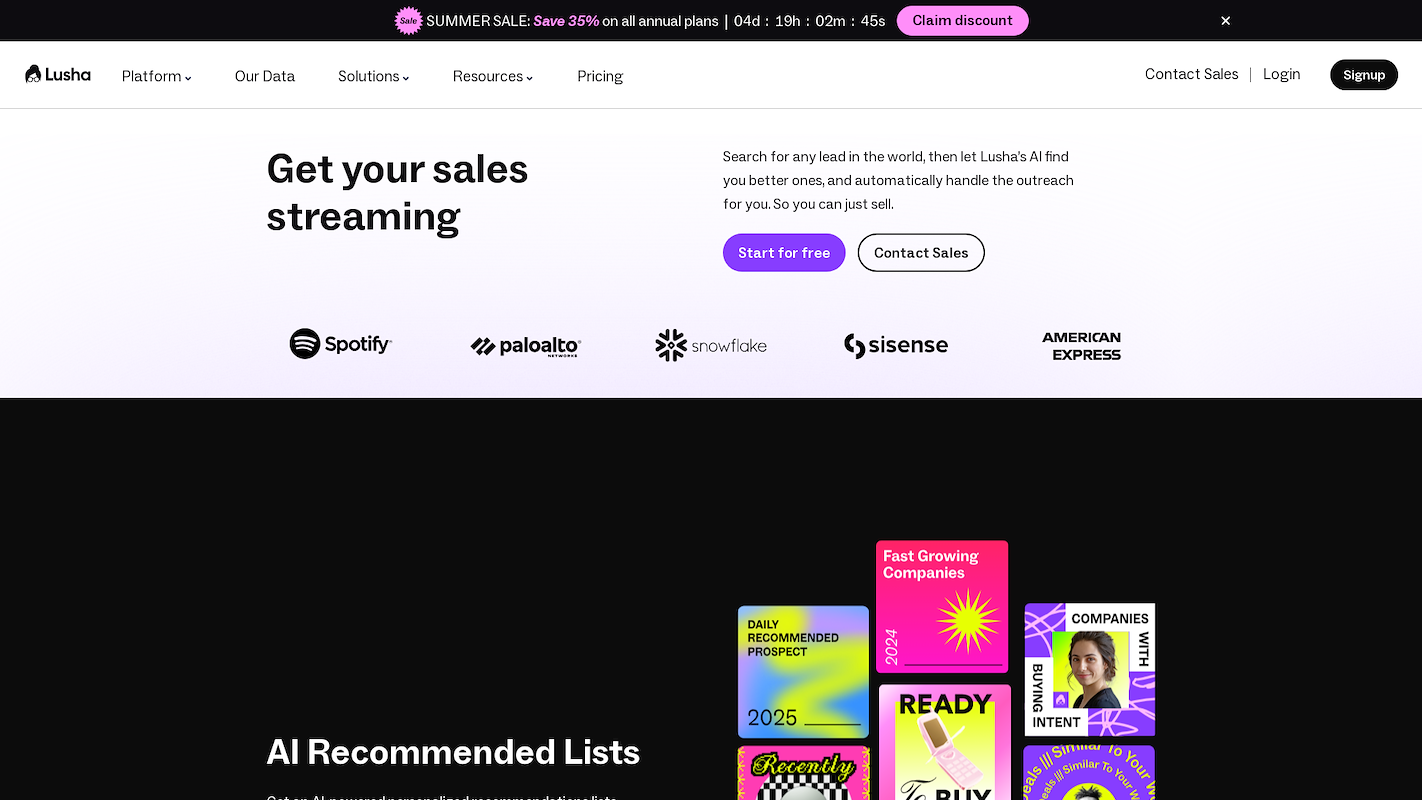
Lusha is a sales intelligence platform that helps revenue teams find B2B leads worldwide. It uses AI to recommend similar prospects and automates outreach. Teams use the platform to build prospect lists and get new, ICP-matched leads without manual research.
The system emphasizes global data coverage and compliance with standards like GDPR and CCPA. It also integrates with popular CRMs and sales tools.
Lusha's Main Features
- Delivers daily, ICP-based lists of companies and decision-makers through its recommendation engine.
- Identifies in-market buyers using intent data and provides real-time notifications on intent triggers.
- Automates and personalizes email sequences with AI-generated copy to engage prospects.
- Records and analyzes sales meetings with its conversation intelligence tool.
Lusha vs. Wiza: A Comparison
Average Review score: 4.3/5 stars based on 1,516 G2 reviews.
- Lusha uses AI Prospect Playlists to automatically create and update lead lists based on your ideal customer profile. This is different from Wiza, which requires manual list creation from LinkedIn searches.
- The tool identifies prospects who actively search for solutions by using buyer intent data. Wiza, in comparison, focuses on contact extraction without these intent signals.
- It includes features to automate and personalize email outreach sequences. This contrasts with Wiza, which primarily provides contact lists for use in separate engagement platforms.
- The platform has a stated focus on global data compliance standards like GDPR and CCPA. Wiza's data comes directly from public LinkedIn profiles, which operates under a different compliance framework.
Potential Downsides of Lusha
- Some users report that Lusha's static database can contain outdated information. This is different from Wiza, which verifies contact data in real time directly from LinkedIn profiles.
- The tool's primary workflow is built around its own database and AI-generated lists. This might be less ideal for teams who prefer Wiza's direct integration with LinkedIn Sales Navigator searches.
- Its credit system can be a concern for some users. The allowance for phone numbers is sometimes found to be limited, which contrasts with Wiza's model of extracting both emails and phone numbers.
Pricing and Cost-Effectiveness
Lusha offers a more affordable entry-level paid plan at $36 per user per month, compared to Wiza's $49 starter tier. Its premium plan is also priced lower at $59 per user per month. For the most current pricing, check the information on Lusha's official website.
4) Hunter

Hunter helps users find professional email addresses and phone numbers. The platform allows a search for a specific professional's contact details or a list of contacts from a single company. It also includes an email verifier to check deliverability for outreach campaigns.
Hunter's Main Features
- Finds all email addresses associated with a specific company domain.
- Includes a campaign tool for composing messages and scheduling follow-ups from a connected email account.
- Verifies email addresses in bulk by processing uploaded spreadsheets.
- Identifies websites based on the technology stack they use.
Hunter vs. Wiza: A Comparison
Average Review score: 4.4/5 stars based on 592 G2 reviews.
- Hunter finds email addresses associated with a specific company domain. This is different from Wiza, which extracts contacts from LinkedIn search results.
- It includes a campaign tool to compose and send outreach emails directly. In comparison, Wiza exports lists for use in separate engagement platforms.
- The tool offers a bulk email verifier to clean existing lists from an uploaded file. Wiza verifies contact data in real-time from LinkedIn profiles instead.
- You can find leads based on the technology a company uses on its website, a feature that Wiza does not have.
Potential Downsides Of Hunter
- Hunter does not build prospect lists directly from LinkedIn searches. This is a key difference from Wiza, which may be a drawback for teams whose workflow centers on Sales Navigator.
- The tool relies on its own database of indexed information. Some users report this can lead to outdated contact details compared to Wiza, which verifies data in real time from LinkedIn profiles.
- Its primary focus is on finding email addresses. Teams that need both verified emails and direct-dial phone numbers might find Wiza's data extraction from LinkedIn more comprehensive.
Pricing and Cost-Effectiveness
Both Hunter and Wiza offer free plans and identically priced Starter tiers at $49 per user per month. For higher-tier plans, Hunter's pricing scales up to $299 per month, while Wiza offers an unlimited individual plan starting at $83 per month, making it a more cost-effective option for heavy individual users.
5) Skrapp.io

Skrapp.io provides professional email addresses and phone numbers for B2B outreach. Sales teams use the platform to find contact data from LinkedIn profiles or company websites to build prospect lists.
The tool discovers contacts in bulk from saved lead lists in Sales Navigator. It also finds contacts associated with a specific company domain.
Skrapp.io's Main Features
- Enriches data by uploading spreadsheets to append and verify contact and firmographic information.
- Extracts emails from company websites while you browse.
- Verifies email addresses individually or in bulk to reduce bounce rates.
- Offers an API to automate email search, enrichment, and verification in your workflows.
Skrapp.io vs. Wiza: A Comparison
Average Review score: 4.2/5 stars based on 170 G2 reviews.
- Skrapp.io provides access to its own database of over 150 million leads. This is different from Wiza, which extracts contact information in real time directly from LinkedIn profiles.
- The tool finds email addresses from company websites as you browse. This offers an alternative lead source compared to Wiza, which focuses on extracting data from LinkedIn searches.
- It includes a bulk email verifier that processes uploaded lists. Wiza, in contrast, verifies contact data individually as it extracts it from LinkedIn.
- The platform provides an API to automate email searches and verification within your workflows. This offers a different integration method than Wiza, which exports lists for other tools.
Potential Downsides Of Skrapp.io
- Skrapp.io relies on its own database, and some users report that this can lead to outdated contact information. This is different from Wiza, which verifies data in real time from LinkedIn profiles.
- Its primary focus is on email discovery. Teams that need both verified emails and direct-dial phone numbers might find Wiza's comprehensive data extraction from LinkedIn more suitable.
- The platform's workflow is not exclusively centered on LinkedIn. Teams that build lists entirely within Sales Navigator may find Wiza’s dedicated integration more direct for their process.
Pricing and Cost-Effectiveness
Both Skrapp.io and Wiza have starter plans priced at $49 per month, though Skrapp.io specifies this includes 1,000 email credits. For higher volume needs, Skrapp.io offers credit-based tiers like 5,000 credits for $99, while Wiza provides an unlimited individual plan starting at $83 per month.
Automate Sales with 11x Digital Workers
If you want to automate sales tasks, consider 11x. Its AI agents find prospects, run outreach, qualify leads, and book meetings. The platform unifies data enrichment and outreach, so you do not need separate tools. This lets your team focus on closing deals.
At 11x, we use AI to run your sales playbook. Alice identifies target accounts, enriches their data, and manages outreach. Julian qualifies inbound leads and schedules meetings. Our platform unifies your GTM stack, so you do not need separate tools.
Book a demo to see how it works.
6) LeadIQ
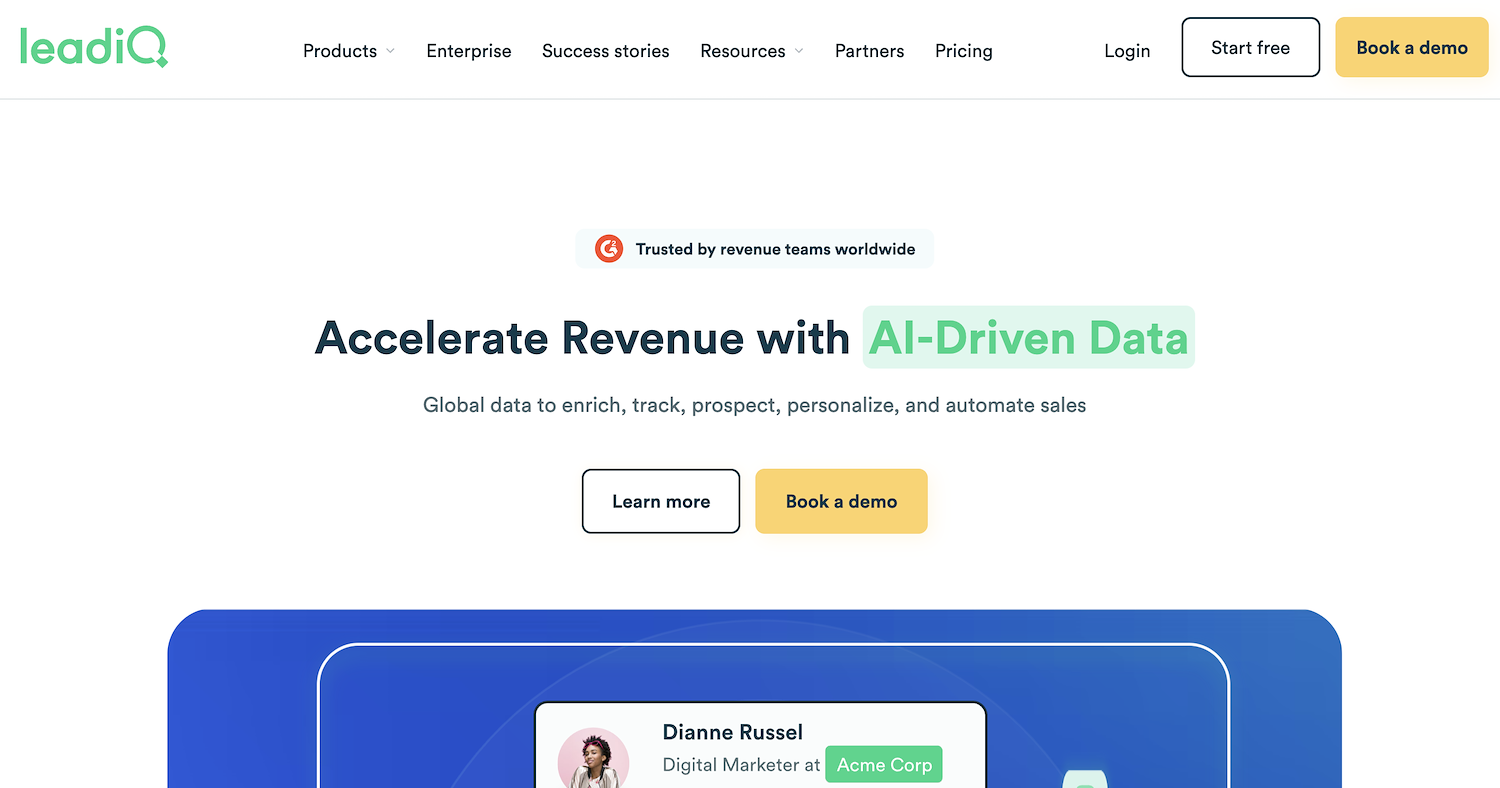
LeadIQ is a sales intelligence platform that helps teams find contact information for prospects. It provides verified email addresses and phone numbers to support outreach efforts. Sales representatives use the tool to build accurate prospect lists and capture data directly from websites or LinkedIn profiles, which then syncs to their CRM.
LeadIQ's Main Features
- Generates personalized outreach messages using its Scribe AI tool.
- Tracks job changes and promotions automatically to alert teams when a champion moves.
- Alerts representatives when prospects change roles and recommends next actions based on the signal.
- Enriches CRM data in bulk and allows for customizable field mapping.
LeadIQ vs. Wiza: A Comparison
Average Review score: 4.2/5 stars based on 1,097 G2 reviews.
- LeadIQ includes an AI tool that helps write personalized outreach messages. This is different from Wiza, which exports contact lists for use in other engagement platforms.
- The platform automatically tracks job changes for your contacts and alerts you. Wiza does not offer this type of sales trigger monitoring.
- It recommends next actions when a prospect changes roles. In comparison, Wiza provides contact data but does not include this type of guided selling feature.
- This tool enriches CRM data in bulk with customizable field mapping, while Wiza's enrichment is part of its real-time contact extraction process.
Potential Downsides Of LeadIQ
- Some users report that LeadIQ's database can sometimes contain outdated contact information. This is different from Wiza, which verifies data in real time directly from LinkedIn profiles to ensure accuracy.
- The tool does not offer bulk contact extraction directly from a saved LinkedIn Sales Navigator list. Wiza, in contrast, builds its workflow around this specific function, which can be faster for teams that create lists this way.
- Its database sometimes lacks direct-dial phone numbers for certain contacts. This can be a drawback compared to Wiza, which extracts both email addresses and phone numbers available on a LinkedIn profile during its real-time scan.
Pricing and Cost-Effectiveness
LeadIQ's entry-level paid plan is slightly cheaper at $45 per user per month versus Wiza's $49. However, Wiza becomes more cost-effective for heavy users with its unlimited individual plan starting at $83 per month, compared to LeadIQ's $89 Pro plan.
7) Snov.io

Snov.io is a sales automation platform. It provides tools to find professional email addresses and phone numbers for outreach. The system includes an email verifier to confirm contacts and a campaign sender for automated sequences. Sales teams use it to build prospect lists and manage their outreach efforts.
Snov.io's Main Features
- Manages deals through a built-in sales CRM with Google Calendar sync and automated stages.
- Includes a deliverability toolkit with automated warm-up and domain placement checkers.
- Sends multichannel campaigns and analyzes reply sentiment in a unified inbox.
- Automates LinkedIn actions and InMail messages with large-scale personalization.
Snov.io vs. Wiza: A Comparison
Average Review score: 4.6/5 stars based on 450 G2 reviews.
- Snov.io includes a built-in sales CRM to manage deals. This is different from Wiza, which exports contact lists for use in external CRM systems.
- The platform offers a deliverability toolkit with an email warm-up feature. Wiza, in comparison, verifies contact data but does not provide tools to improve sender reputation.
- It allows users to send multichannel campaigns directly from its platform. This contrasts with Wiza's workflow, which requires exporting contact lists to a separate sales engagement tool.
- The tool can automate certain LinkedIn actions and personalized InMail messages. Wiza extracts data from LinkedIn but does not include features for automating engagement on the platform.
Potential Downsides Of Snov.io
- Snov.io does not build prospect lists directly from LinkedIn Sales Navigator searches. This is different from Wiza, which may be more efficient for teams whose workflow is centered on Sales Navigator for list creation.
- Some users report that its database can contain outdated contact information. Wiza, in comparison, verifies data in real time from public LinkedIn profiles, which can provide more current details for outreach.
- The platform's main function is email discovery. Teams that require both verified emails and direct-dial phone numbers might find Wiza's data extraction from LinkedIn to be more comprehensive for their needs.
Pricing and Cost-Effectiveness
Snov.io offers a more affordable entry-level plan at $39 per month, compared to Wiza's $49 starter tier. For higher volume needs, Wiza's unlimited individual plan starts at $83 per month, which can be more cost-effective than Snov.io's Pro plan at $99 per month.
8) Seamless.AI
Seamless.AI is a sales intelligence platform that provides verified B2B contact information. Its search engine finds emails and phone numbers in real time. Sales teams use it to build prospect lists and enrich their existing data for outreach campaigns.
Seamless.AI's Main Features
- Finds contact and company data with a real-time search engine.
- Uses AI to recommend new leads based on your ideal customer profile.
- Integrates directly with CRMs like Salesforce to sync data automatically.
- Enriches existing contact records with updated information.
Seamless.AI vs. Wiza: A Comparison
Average Review score: 4.2/5 stars based on 1,431 G2 reviews.
- Seamless.AI uses a real-time search engine across the web, while Wiza extracts data directly from LinkedIn profiles.
- The platform uses AI to recommend new prospects. This is a lead generation feature that Wiza does not have.
- It is designed as a comprehensive tool to build leads. Wiza, in contrast, is a specialized utility to export lists from LinkedIn.
- Seamless.AI offers direct CRM integrations to sync data. Wiza's primary function is to export lists for use in other tools.
Potential Downsides Of Seamless.AI
- Some users report that the credit system can be restrictive, with daily limits even on plans marketed as "unlimited."
- The platform's interface and broad feature set can be complex for teams that only need a simple contact extractor like Wiza.
- While it uses real-time verification, some user feedback suggests data accuracy can be inconsistent compared to Wiza's direct data pull from LinkedIn.
Pricing and Cost-Effectiveness
Seamless.AI typically uses custom pricing and annual contracts for its paid plans. This is less transparent than Wiza's monthly tiers. While it has a free plan, its paid options are often geared toward teams and may represent a larger investment than Wiza's individual plans.
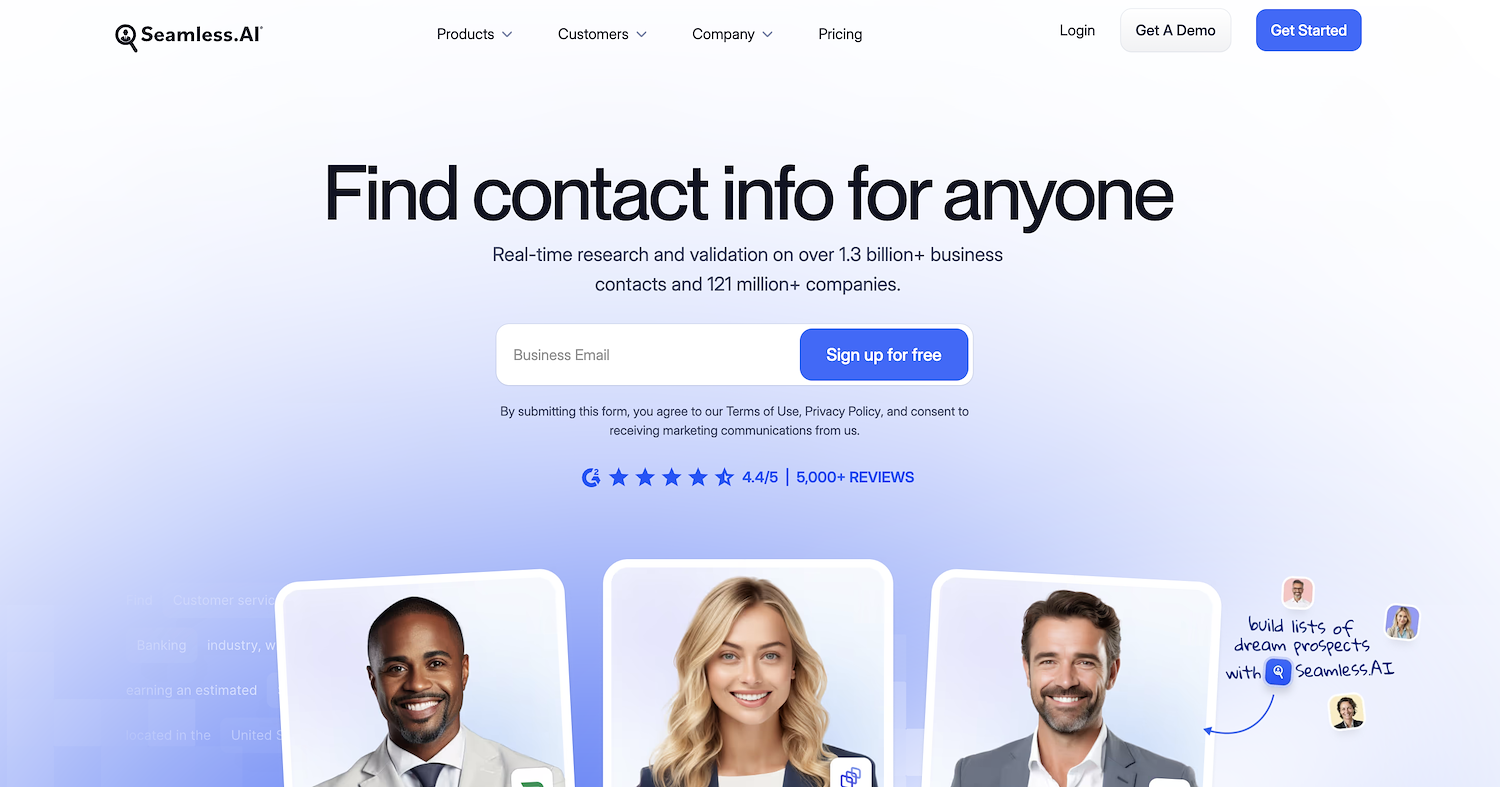
Seamless.AI is a sales intelligence platform with a real-time search engine to find verified B2B emails and phone numbers. Sales teams use it to build prospect lists or enrich data in their CRM. The platform also uses AI to recommend new leads based on an ideal customer profile.
Seamless.AI's Main Features
- Provides buyer intent data and tracks job changes to identify timely sales triggers.
- Offers industry-level research to help build targeted outreach strategies.
- Integrates with CRM and marketing automation platforms, including Salesforce and HubSpot.
- Cleans and enriches contact data to improve lead validation and overall quality.
How Seamless.AI Compares to Wiza
Average Review score: 4.4/5 stars based on 5,067 G2 reviews.
- Seamless.AI uses a real-time search engine to find contacts across the web. This is different from Wiza, which extracts data only from LinkedIn profiles.
- The platform uses AI to recommend new leads that fit your ideal customer profile. In comparison, Wiza requires you to build prospect lists manually from LinkedIn searches.
- This tool provides buyer intent data and tracks job changes to identify timely sales opportunities. Wiza does not offer these types of sales trigger signals.
- It integrates directly with CRMs like Salesforce and HubSpot to sync data automatically. This offers a different workflow than Wiza, which exports lists for you to use in other tools.
Potential Downsides Compared To Wiza
- Seamless.AI does not extract contacts directly from saved LinkedIn Sales Navigator lists. This is different from Wiza, which builds its workflow around this function for faster list creation for teams that rely on LinkedIn.
- Some users report its data can be less current. Wiza verifies information in real time from LinkedIn profiles, which individuals often keep up-to-date themselves, potentially leading to higher accuracy for contact details.
- The tool often requires an annual contract and custom pricing. This model is less flexible compared to Wiza, which offers transparent monthly plans that are easier to start or stop for smaller teams or individual users.
Pricing and Cost-Effectiveness
Wiza offers transparent monthly plans starting at $49 per user, making it a flexible option for individuals or small teams. Seamless.AI uses custom pricing and annual contracts, which can be a larger investment. For detailed pricing, you must request a quote on Seamless.AI's official website.
9) RocketReach
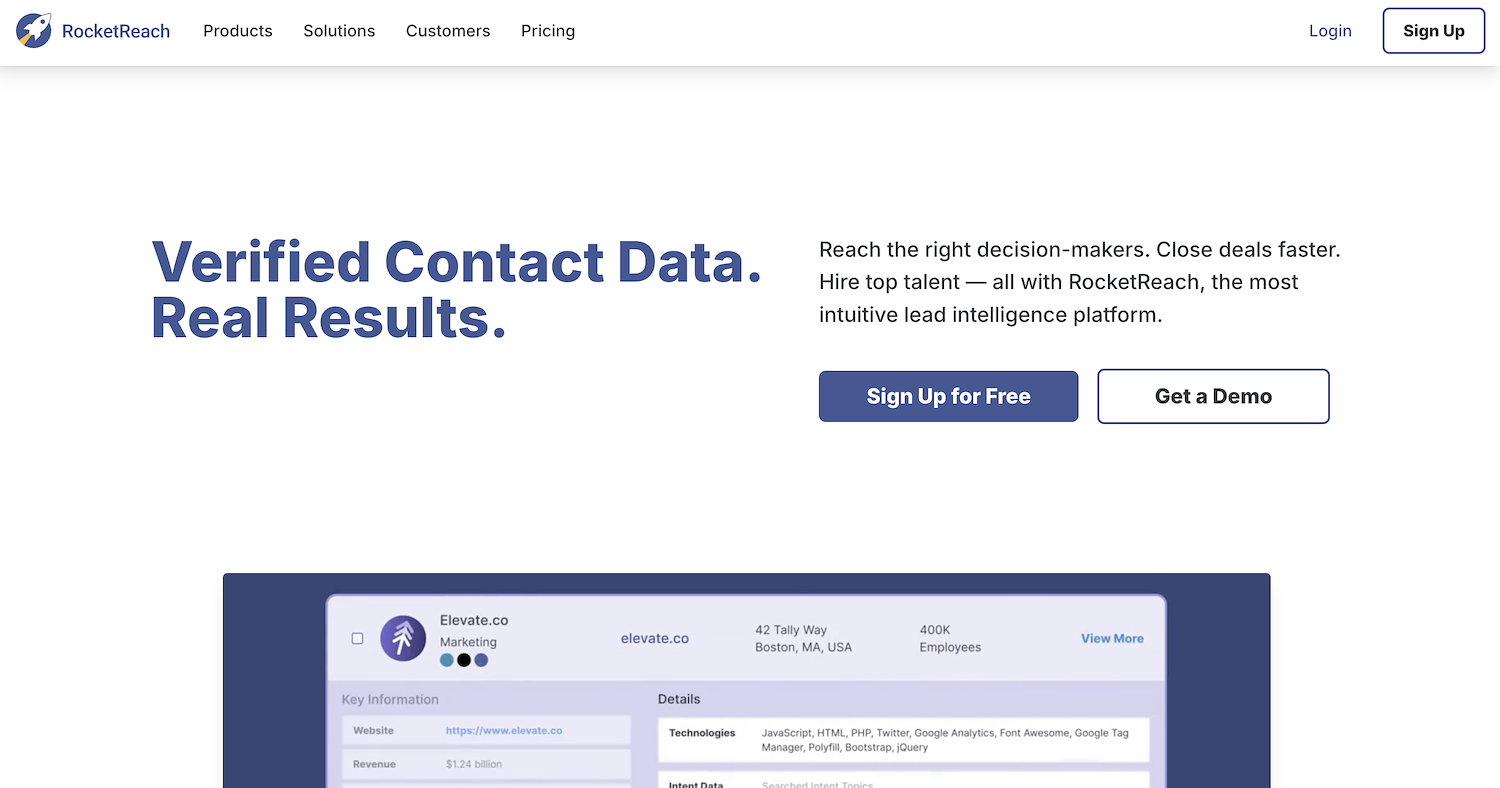
RocketReach is a platform to find professional email addresses and phone numbers. It draws from a large database of contacts, which allows users to look up individuals or build lists. Sales and recruitment teams use the service to source contacts for outreach campaigns.
RocketReach's Main Features
- Accesses a database of over 700 million professionals across 35 million companies.
- Offers advanced search capabilities, bulk lookups, and an API for custom workflows.
- Integrates with Salesforce, HubSpot, and Salesloft through prebuilt connections and Zapier.
- Provides specialized contact data for professionals in the healthcare industry.
How RocketReach Compares To Wiza
Average Review score: 4.4/5 stars based on 918 G2 reviews.
- RocketReach accesses a database of over 700 million professionals, which provides a wider search scope compared to Wiza's focus on LinkedIn profiles.
- It offers direct integrations with CRMs like Salesforce and HubSpot, which is different from Wiza's primary function of exporting lists for manual import.
- The tool provides specialized contact data for the healthcare industry, a feature that Wiza does not offer for industry-specific filtering.
- This platform includes an API to build custom data workflows, allowing for more flexible integration than Wiza's standard list export function.
Potential Downsides Compared To Wiza
- RocketReach relies on its own large database, and some users report that this can lead to outdated contact information. This is different from Wiza, which verifies data in real time from LinkedIn profiles that individuals often update themselves.
- The platform does not extract contacts in bulk from a saved LinkedIn Sales Navigator search. Wiza, in contrast, builds its primary workflow around this specific function, which can be more efficient for teams that create lists this way.
- Its paid plans use a credit-based system that limits the number of monthly lookups. This model can be restrictive for high-volume use compared to Wiza, which offers an unlimited plan for individual users.
Pricing and Cost-Effectiveness
RocketReach’s paid plans use a credit system that limits monthly lookups. This can be restrictive for high-volume needs. In contrast, Wiza offers an unlimited individual plan starting at $83 per month, which may be more cost-effective for heavy users.
RocketReach's entry-level plan starts at $99 per month for 100 lookups, compared to Wiza's $49 starter plan. For high-volume needs, Wiza's unlimited individual plan starting at $83 per month can be more cost-effective than RocketReach's credit-based tiers, such as its Pro plan at $165 for 250 lookups.
10) Clearbit
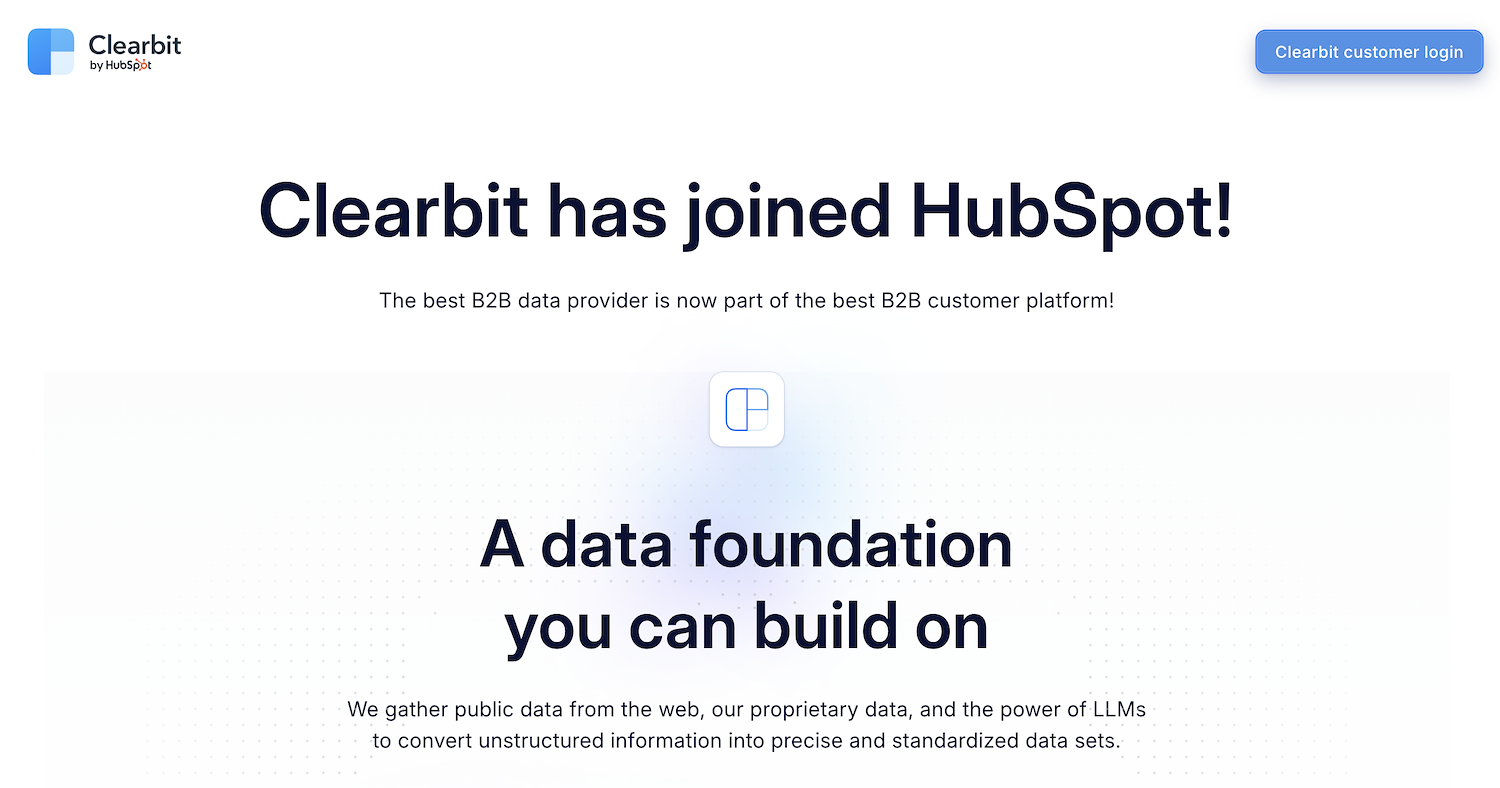
Clearbit is a marketing data platform that provides contact and company information for B2B businesses. Teams use its data to enrich records, identify target accounts, and understand customers. The service helps find new prospects and convert website visitors.
It provides verified email addresses and phone numbers to help build a sales pipeline.
Clearbit's Main Features
- Appends over 100 data points to company and employee records for data enrichment.
- Identifies anonymous companies visiting your website with its Reveal feature.
- Integrates with CRM platforms like HubSpot to automate data workflows.
- Shortens website forms by hiding or autofilling known fields.
How Clearbit Compares To Wiza
Average Review score: 4.4/5 stars based on 626 G2 reviews.
- Clearbit enriches records with over 100 data points, providing more detailed company and employee information compared to Wiza's focus on contact extraction.
- It identifies anonymous companies that visit your website with its Reveal feature, offering a source for new leads that Wiza does not provide.
- The tool integrates directly with platforms like HubSpot to automate data workflows, which is different from Wiza's function of exporting lists for use in other tools.
- This platform can shorten website forms by autofilling known information to improve lead conversion, a function outside of Wiza's scope.
Potential Downsides Compared To Wiza
- Clearbit does not extract contacts directly from LinkedIn Sales Navigator searches. This is different from Wiza, which builds its workflow around this function for teams that create prospect lists on LinkedIn.
- Some users report that its database can contain outdated information. Wiza, in contrast, verifies data in real time from public LinkedIn profiles, which individuals often update themselves.
- The platform is a comprehensive marketing intelligence tool. Teams that only need a simple utility to export contact lists from LinkedIn might find its broad feature set more complex than Wiza's focused function.
Pricing and Cost-Effectiveness
Wiza offers transparent monthly plans starting at $49 per user, providing flexibility for individuals and small teams. In contrast, Clearbit uses a custom pricing model geared toward enterprise customers, which typically represents a larger investment. For detailed pricing, you must request a quote on Clearbit's official website.
Which Wiza Alternative Should You Choose?
Many variables affect the choice of a Wiza alternative, including your team's workflow and budget. This guide reviewed the top options to help you compare their features and pricing.
If you want to automate your sales process, consider 11x. Its AI agents handle prospecting, outreach, and lead qualification, so your sales team can focus on closing deals instead of repetitive tasks. The platform unifies your sales stack into a single system.




